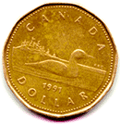

 MouseMaster MouseMaster Canadian Corner Canadian Corner Grammar Central Grammar Central Crazy English Crazy English Terrible Teacher Terrible Teacher Flashed ESL Flashed ESL American Stories American Stories
|
 |

Instructions: 1. Either print this exercise with the questions and complete them in a traditional fashion, or 2. Press to run a self-marked version of this exercise.  Hiking through the branches and backwoods of a thick Canadian forest you might be lucky enough to spot a loon gliding peacefully across a hidden lake. But if you want to see the loon up close, it's a lot easier searching for the nearest branch of your local bank.  That's where you can find the loon beautifully engraved on Canada's one-dollar coin. One side of each coin features Ontario artist Robert-Ralph Carmichael's design of a loon floating in water; on the other side is Arnold Machin's portrait of Queen Elizabeth. The coin was nicknamed "the loonie" the moment it made its public debut. That's where you can find the loon beautifully engraved on Canada's one-dollar coin. One side of each coin features Ontario artist Robert-Ralph Carmichael's design of a loon floating in water; on the other side is Arnold Machin's portrait of Queen Elizabeth. The coin was nicknamed "the loonie" the moment it made its public debut.The introduction of the "loonie" into general use was the first major change to the Canadian coinage system in over 50 years. It was designed to replace the country's supply of one-dollar bills, which was costing the Government of Canada over $16.6 million to replace each year. The thin paper dollars had only a one-year life span, while the coins are each expected to last as long as twenty years. Dollar coins have remained popular with collectors since the first one was issued by the Bank of Canada in 1935. However, many special interest groups and businesses expressed the need for a dollar coin for more practical use. Transit companies, for example, were spending thousands of dollars every year unclogging fare boxes jammed with rolled and crumpled dollar bills. Vending machine operators wanted a new coin so they could expand the variety of products they put into their machines. And support groups for the visually impaired welcomed the idea of a coin that was easier to identify. In June 1986, the House of Commons adopted a bill which gave the Royal Canadian Mint proper authority to produce and distribute the new coin. The original design was engraved by the mint in Ottawa, but the master dies for the new coin were lost by a courier company en route to Winnipeg! In January 1987, the Government of Canada authorized a new design featuring the common loon. The new one-dollar coin was introduced to the public in May, 1987, in a special ceremony at the Mint's Winnipeg facility. The first 100 million of Canada's shiny new coins were shipped across the country later in July. In the next two years, the mint put more than 185 million "loonies" into circulation. As a result, the Bank of Canada announced in June 1989 that they would no longer be issuing the $1 paper bill. The eleven-sided, yellow-gold coin utilizes the very best in Canadian resources and talent. Nickel from Inco Metals Company of Sudbury was chosen for its durability and low cost. Bronze-plating was completed by Sherritt Gordon Mines of Fort Saskatchewan. Each of the coins is 26.5 millimeters in diameter and 2 millimeters thick. They weigh just 2 grams more than a twenty-five cent piece. The $1 coin is now recognized across Canada as practical and convenient legal tender, proving it wasn't such a "loony" idea after all! |
 |
 | ||
Copyright © 2006 Centre for Education & Training. All Rights Reserved